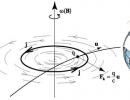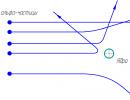Teaching English transcription for children. English sounds for children: learning to read transcription correctly. Now let's practice the sound of tongue twisters
Learn more about what the prime, colon, parentheses, and other symbols mean.
You can look at another version of the English transcription and, if necessary, print or copy it for editing in Microsoft Word
English Transcription
Pronunciation of English sounds.
Pronunciation of English vowels.
The pronunciation of English sounds is presented in Russian letters, you should understand what to convey the correct English pronunciation Using the Russian alphabet is not possible.
- ɑː long, deep
- ʌ short vowel a, as in the Russian word run.
- ɒ = ɔ - short, open about
- ɔː - long o
- zː - long vowel e, as in the Russian word hedgehog.
- æ - open e
- e - like e in the word these
- ə - unclear unstressed sound, similar to e
- iː - long and
- ɪ - short, open and
- ʊ = u - short u, pronounced with a slight rounding of the lips.
- uː - long u pronounced without strong rounding of the lips.
Two-vowel sounds
Pronunciation of English consonants.
- p - p
- b - b
- m - m
- f - f
- v - in
- s - s
- z - z
- t - resembles the Russian sound t, pronounced with the tongue positioned at the gums.
- d - resembles the Russian sound d, pronounced with the tongue positioned at the gums.
- n - resembles the Russian sound n, pronounced with the tongue positioned at the gums.
- l - resembles the Russian sound l, pronounced with the tongue positioned at the gums.
- r is a very hard sound pronounced without vibration of the tongue. Corresponds to the sound r in the word lot
- ʃ - soft Russian sh
- ʒ - soft Russian zh, as in the word yeast.
- tʃ- h
- ʤ - similar to the Russian sound j (voiced ch)
- k - k
- h - inhale, reminiscent of a faintly pronounced x sound
- ju - long yu in the word southern
- je - sound e in the word spruce
- jɔ - sound ё in the word fir-tree
- jʌ - the sound I in the word pit
- j - resembles the Russian sound й before vowels. Occurs in combination with vowels.
English consonant sounds that have no approximate correspondence in Russianː
- w - formed with the help of rounded lips (as in whistling). It looks like a sound uttered with just lips. In translation it is denoted by the letters в or у ː W illiams - Williams, Williams.
- ƞ - Open your mouth slightly and say n without closing your mouth.
- ɵ - Move the slightly spread tip of your tongue between your teeth and pronounce Russian with
- ð - Move the slightly spread tip of your tongue between your teeth and pronounce Russian z
Did you know that english alphabet consists of 26 letters and 46 different sounds? The same letter can convey several sounds at the same time. Just don't panic! We'll tell you how easy it is to remember English sounds without boring tables and cramming.
As a rule, in class English child maintains a separate dictionary, in which the pages are divided into three columns: “word”, “transcription”, “translation”. New words are written down there, which you then need to learn. And if everything is clear with the “word” and “translation” columns, then with “transcription” there are often difficulties.
What is transcription? This is a kind of instruction on how to read a word. It is usually written in square brackets. For example: . The symbols that are inside square brackets are sounds in English. One symbol = one sound. Only these symbols do not always look like letters of the alphabet . Let's look at the English sounds that are most difficult for a child and how to learn them:
We select associations
It's no secret that complex things are easier to remember using the method of associations. This rule works especially well for children.
ʊ
- short [y] - very similar to the icon "horseshoe"
æ
- wide [e] - open your mouth wide and say “e”. We call this symbol "bug icon" 🐞
ŋ
- [ny] - a funny sound that is similar to how the Baby Elephant spoke in the cartoon “38 Parrots” 🐘. You need to say “n”, but a little “on the nose”, like you have a runny nose. Try holding your nose with your fingers, opening your mouth slightly and saying “n.” Happened?
ð
- interdental [z]
θ
- interdental [s]
To remember this pair of sounds, you can tell your child a whole fairy tale: “Once upon a time there lived a little bunny (our tongue). But he was very timid, so he sat in the hole (in his mouth) all the time. But one day he dared to stick the very tip of his nose out of the hole (put the tip of the tongue between the teeth). At first he said quietly [θ], and then loudly [ð].
s, d, n, t- [s], [d], [n], [t] - remember the episode of “Jumble” about English pronunciation? “You need to talk as if there is a hot potato in your mouth,” is the best explanation for the baby. When you make these sounds the tongue touches the hard palate and alveoli, a little further than in Russian.
r- [r] - the English “r” is not like ours. In Russian, the tongue seems to tremble in the mouth. In English, language "wraps up" tip back towards the soft palate.
w- [у]/[в] - there is no such sound in the Russian language either. First we stretch out our lips, trying to say “y”, but then our lips should seem "spring", without closing and returning to a smile. Remember how you say “Wow!”
e- narrow [e] - similar to the Russian “e” without the “y”. When pronouncing, we open our mouth quite a bit.
ə
- dull [e] - dull, slightly “compressed” sound, very short and almost indistinguishable. When you say the word "m" O loko", then you pronounce this sound in place of the first “o”. The symbol is called funny– "schwa".
ɜ
- middle [e] - reads like the letter e in the word “ice”.
j- [th] - very important don't be confused with the letter Jj (“jay”)! In transcription, this symbol means something completely different from the letter.
To make things even easier, we drew the main characters of English transcription with the appropriate sounds of the Russian language.

AllRight.com Tip: Tell your child that he copes with sounds brilliantly. After all, at this stage, the baby should feel relaxed and not hesitate to experiment. Otherwise, the child will think that he looks funny and will refuse to continue classes.
If home lessons do not bring the desired results, come to us. AllRight.com teachers will always find an easy way to even the most complex knowledge 📚 free!
Hey, folks! In today's article we will look at sounds in English. We will discuss how best to teach transcription of sounds to children, what associations can be used to explain sounds, and consider examples of letters and sounds in transcription.
There are 24 letters in English, but these letters can represent 46 different sounds. Almost every letter can convey several sounds. Interesting, isn't it?
Starting from the 1st or 2nd grade, the child gets himself a dictionary, where he writes down English words with translation and transcription. Then these words need to be learned. Writing a word and a translation is not that difficult, but how can you explain to a child all the nuances of pronunciation of sounds in English and their spelling in transcription?
Today we will try to figure this out.
How best to teach transcription of sounds for children
We suggest starting to learn English sounds with the help of rhymes and songs. They will help your child become familiar with new letters and sounds in a relaxed atmosphere.
The more often your child listens to and pronounces letters and sounds, the faster he will remember the correct pronunciation.
Here are examples of some videos:
Associations can also help in learning sounds, especially if we are talking about sounds that are difficult to pronounce.
We select associations
ʊ
- short [y] - very similar to the “horseshoe” icon.
æ
- wide [e] - open your mouth wide and say “e”.
ŋ
- [nn] - a funny sound that looks like a baby elephant from the cartoon “38 Parrots”. You need to say “n”, but “on the nose”, as if you have a runny nose.
r- [r] - the English “r” is not like ours. In Russian, the tongue seems to tremble in the mouth. In English, the tongue "curls" its tip back toward the soft palate.
w- [u]/[v] - there is no such sound in Russian either. First, we stretch our lips, trying to say “y,” but then the lips should “spring,” as it were, without closing and returning to a smile. Remember how you say “Wow!”
ð
- interdental [z].
θ
- interdental [s].
To remember the last pair of sounds, you can tell your child a fairy tale:
“Once upon a time there lived a little bunny (our language). But he was very timid, so he sat in the hole (in his mouth) all the time. But one day he dared to stick the very tip of his nose out of the hole (put the tip of the tongue between the teeth). At first he said quietly [ θ ], and then loudly [ ð ].

e- narrow [e] - similar to the Russian “e” without the “y”. When pronouncing, we open our mouth quite a bit.
ə
- dull [e] - dull, slightly “compressed” sound, very short and almost indistinguishable. When you say the word “milk,” for example, you pronounce approximately this sound in place of the first “o.”
ɜ
- middle [e] - reads like the letter “e” in the word “ice”.
j- [th] - it is very important not to confuse it with the letter “J” (“jay”). In transcription, this symbol means something completely different from the letter.
|
Sound |
Examples |
|
box, table, about, black, abnormal, brother |
|
|
ready, leader, dog, road, fiddle, dry |
|
|
fill, fast, photo, life, left, friend |
|
|
cat, key, America, school, neck, doctor |
|
|
lip, look, life, late, small, play |
|
|
my, milk, smell, man, him, sum |
|
|
[ŋ /n] |
long, song, bring, singer, win, ran |
|
pen, peace, part, happy, help, lip |
|
|
some, start, center, city, cycle |
|
|
talk, tell, little, tea, water, cat |
|
|
river, oven, never, view, very, visit |
|
|
zoom, zebra, zip, puzzle, buzz |
|
|
they, them, than, this, bathe |
|
|
thick, theme, thin, myth, tenth |
|
|
wool, woe, wait, well, wheel, with |
|
|
Jim, Jill, June, danger, gym |
|
|
add, bad, map, family, plan, narrow |
|
|
bus, duck, dull, fund, love, come, luck |
|
|
far, gar, palm, calm, father, garden |
|
|
pin, pit, it, lip, fill, tip |
|
|
leave, meel, peel, seen, neat |
|
|
box, got, pot, bother, odd, often |
|
|
wall, stall, talk, call, salt, raw |
|
|
stood, hood, foot, loose, room |
|
|
pen, bed, tent, egg, desk, end |
|
|
bird, girl, first, learn, turn |

If you find it difficult to understand the pronunciation of sounds, then there is transcription with simplified pronunciation rules for beginners.

Consonants in English
Consonants pronounced energetically, intensely and abruptly.
|
[s] tongue ends on the alveoli |
|
|
[h] tongue ends on the alveoli |
|
|
weak [x], light exhalation |
|
|
[p] aspirated |
|
|
[t] end of the tongue on the alveoli, with aspiration |
|
|
[d] tongue ends on the alveoli |
|
|
[k] aspirated |
|
|
[n] tongue ends on the alveoli |
|
|
[l] tongue ends on the alveoli |
|
|
[r] the tongue ends on the alveoli, but does not touch the palate (without vibration) |
|
|
lips “in a tube”, sharply unclench, like [wa], only a single sound |
|
|
interdental voiceless, similar to [s] (bite your tongue a little) |
|
|
interdental voiced, similar to [z] (bite your tongue a little) |
|
|
[n], the sound seems to come out through the nose ([ng] “into the nose”) |
|
|
average between [w] and [sch] |
|
|
soft [f], almost [f] |
|
|
soft [j], almost [j], like a single sound |
|
|
weak [th] |

Main sounds in English
Vowels sounds divided into:
- seven brief vowels (i, o, u, ʌ, e, ə, æ);
- five long vowels (i:, ɑ:, ɔ:, u:, ə:);
- eight diphthongs(eɪ, ɑɪ, ɔɪ, au, əu, uə, ɪə, ɛə);
- And triphthongs(aiə, auə, juə, …).
|
short [and], sound between [and] and [s] |
|
|
short [o] |
|
|
short [y], lips are not in a “tube”, but slightly rounded |
|
|
short [a] |
|
|
short [e] |
|
|
unstressed [uh] |
|
|
average between [e] and [a] |
|
|
long [and] |
|
|
long [a] |
|
|
long [o] |
|
|
long [y], lips are not in a “tube”, but slightly rounded |
|
|
long sound between [e] and [e] |
|
|
long [yu] |
|

Conclusion
We hope that this article will help you explain to your child how to correctly pronounce sounds in English.
Pronounce words correctly, speak beautifully. To do this, you need to read, listen, talk and sing more in English. Make your English fly!
Big and friendly EnglishDom family
Did you know that the English alphabet consists of 26 letters and 46 different sounds? The same letter can convey several sounds at the same time. Just don't panic! We'll tell you how easy it is to remember English sounds without boring tables and cramming.
As a rule, in English lessons, a child keeps a separate dictionary, in which the pages are divided into three columns: “word”, “transcription”, “translation”. New words are written down there, which you then need to learn. And if everything is clear with the “word” and “translation” columns, then with “transcription” there are often difficulties.
What is transcription? This is a kind of instruction on how to read a word. It is usually written in square brackets. For example: . The characters that are inside the square brackets are the sounds of the English language. One symbol = one sound. Only these symbols do not always look like letters of the alphabet . Let's look at the English sounds that are most difficult for a child and how to learn them:
We select associations
It's no secret that complex things are easier to remember using the method of associations. This rule works especially well for children.
ʊ
- short [y] - very similar to the icon "horseshoe"
æ
- wide [e] - open your mouth wide and say “e”. We call this symbol "bug icon" 🐞
ŋ
- [ny] - a funny sound that is similar to how the Baby Elephant spoke in the cartoon “38 Parrots” 🐘. You need to say “n”, but a little “on the nose”, like you have a runny nose. Try holding your nose with your fingers, opening your mouth slightly and saying “n.” Happened?
ð
- interdental [z]
θ
- interdental [s]
To remember this pair of sounds, you can tell your child a whole fairy tale: “Once upon a time there lived a little bunny (our tongue). But he was very timid, so he sat in the hole (in his mouth) all the time. But one day he dared to stick the very tip of his nose out of the hole (put the tip of the tongue between the teeth). At first he said quietly [θ], and then loudly [ð].
s, d, n, t- [s], [d], [n], [t] - remember the episode of “Jumble” about English pronunciation? “You need to talk as if there is a hot potato in your mouth,” is the best explanation for the baby. When you make these sounds the tongue touches the hard palate and alveoli, a little further than in Russian.
r- [r] - the English “r” is not like ours. In Russian, the tongue seems to tremble in the mouth. In English, language "wraps up" tip back towards the soft palate.
w- [у]/[в] - there is no such sound in the Russian language either. First we stretch out our lips, trying to say “y”, but then our lips should seem "spring", without closing and returning to a smile. Remember how you say “Wow!”
e- narrow [e] - similar to the Russian “e” without the “y”. When pronouncing, we open our mouth quite a bit.
ə
- dull [e] - dull, slightly “compressed” sound, very short and almost indistinguishable. When you say the word "m" O loko", then you pronounce this sound in place of the first “o”. The symbol is called funny– "schwa".
ɜ
- middle [e] - reads like the letter e in the word “ice”.
j- [th] - very important don't be confused with the letter Jj (“jay”)! In transcription, this symbol means something completely different from the letter.
To make things even easier, we drew the main characters of English transcription with the appropriate sounds of the Russian language.

Advice site: Tell your child that he copes with sounds brilliantly. After all, at this stage, the baby should feel relaxed and not hesitate to experiment. Otherwise, the child will think that he looks funny and will refuse to continue classes.
If home lessons do not bring the desired results, come to us. The site's teachers will always find an easy way to even the most complex knowledge 📚 The trial lesson is free!
Each of us, when opening an English dictionary, came across such a phenomenon as transcription - this is the recording of the sound of a letter or word in the form of special phonetic symbols. This is a very important linguistic element and today we will explore it with you.
Why do children need transcription in English?Transcription refers to phonetics. It is often found in the languages of the Indo-European group. English transcription has its own characteristics, it conveys the word as it is read, and is necessary especially for beginners and for children learning a foreign language.
In English, words are not read as they are written, as can be seen in Russian or Spanish. Every word in the English language, every letter combination, every diphthong or triphthong has its own characteristics, its own reading rules. This is precisely the function that English transcription performs - to teach children to read and speak English correctly.
Working with the dictionary correctly
In one of our articles, we already mentioned how important it is to work with a dictionary when studying a foreign language. This is especially important for children. The dictionary presents a word in English, its translation into Russian and the transcription of this word, that is, it shows us how it is read, and therefore pronounced.
If we talk about Google translator, it gives us voice pronunciation. It is also good. However, it is important for children to see the transcription of the word, read it out loud several times, and memorize everything visually. The child does the phonetic work himself.
The voice pronunciation of Google Translator can be followed by transcription in the dictionary and repeated after the speaker. But be sure to pay attention to the transcription signs in the dictionary! In this way, we learn to read English and pronounce words correctly. By understanding phonetics, you can read words on your own, without outside help.
Teaching children to work with English transcriptionRemember the rules of reading in English
So, don't let your phonetics and pronunciation lessons go in vain. Pay attention to the basic rules of reading English words, which have several types of syllables. But to understand the entire system, it is necessary to distinguish and remember only two types: an open syllable and a closed syllable.
- Open syllable must end in a vowel: stone, game, like - a vowel in a word is read the same way as in the alphabet
- Closed syllable must end in a consonant: cat, pen, bus - a vowel in a syllable gives a different sound, it does not correspond to the written letter.
Basically, English sounds correspond to the sounds of the Russian language, for example: [b] - [b]; [p] - [p] etc.
But there are some differences: - [j] (joy); [∫] - [w] (shadow); - [h] (teacher).
There are also sounds that have no analogue in Russian: [θ] - think; [ð] - mother; [ŋ] - dreaming; [w] - walk.
And finally, we move on to diphthongs. There are several of them: [əu] - [оу] (coat); [au] - [au] (how); [ei] - [hey] (pray); [oi] - [oh] (join); [ai] - [ai] (like).
Download 9 phonetic games for fun activities
How to make friends with transcription?
We would like to repeat that the English transcription will be especially useful for children and beginners. When learning English with your children, or teaching it, do not forget about transcription lessons; teach children pronunciation from an early age. It is clear that at first it will be difficult for them, for children younger age all these icons and symbols will be complex.
But don’t let your child give up, encourage him. Let your lessons introduce your child to this phonetic phenomenon every time:
- Introduce children to transcription and reading rules. Explain what it is and why it is needed
- Show the kids how to write the icons and transcription symbols, invite them to write them down for you.
- Read a few transcribed English words and write them down with the children. Ask the guys to rewrite them
- Suggest a few foreign words with transcriptions and ask the children to read them
- Later, working with English vocabulary, ask the guys to write down not only the translation of words, but also their sound
- Work with transcription every lesson so that children get used to it.
To make it easy and interesting for your child to comprehend sound writing, use various forms, methods and visual aids in your work. All kinds didactic games related to phonetics, exercises will help you with this. Phonetic icons of English transcription can be presented in the form of funny pictures, colorful drawings, etc. The topic is quite difficult for a child, so it is important to use the imagination to diversify the activities.
We hope that you will be able to make friends with transcription, because with it the English language becomes simpler and more accessible.






